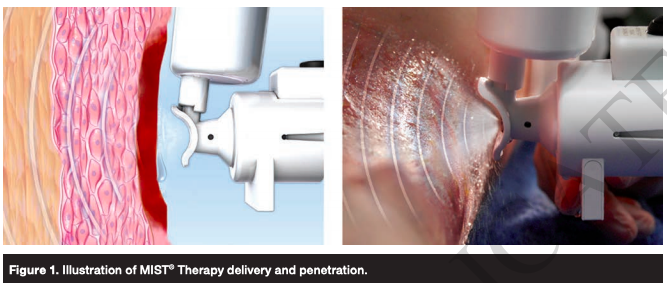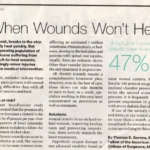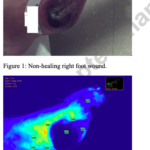
Effects of Noncontact, Low-frequency Ultrasound to Standard Care in Healing Venous Leg Ulcers
Abstract: Current scientific evidence suggests venous leg ulcers (VLUs) that do not respond to guideline-defined care may have a wound microenvironment that is out of physiological balance. A prospective, randomized, controlled, multicenter trial was conducted to compare percent wound size reduction, proportions healed, pain, and quality-of-life (QOL) outcomes in patients randomized to standard care (SC) alone or SC and 40 kHz noncontact, low-frequency ultrasound (NLFU) treatments 3 times per week for 4 weeks. One hundred, twelve (112) eligible participants with documented venous stasis, a VLU >30 days’ duration, measuring 4 cm2 to 50 cm2 , and demonstrated arterial flow were enrolled. Of these, 81 reduced <30% in size during the 2-week run-in study phase and were randomized (SC, n = 40; NLFU+SC, n = 41). Median age of participants was 59 years; 83% had multiple complex comorbidities. Index ulcers were 56% recurrent, with a median duration of 10.3 months (range 1 month to 204.5 months) and median ulcer area of 11.0 cm2 (range 3.7 cm2 –41.3 cm2). All participants received protocol-defined SC compression (30–40 mm Hg), dressings to promote a moist wound environment, and sharp debridement at the bedside for a minimum of 1 time per week. Ulcer measurements were obtained weekly using digital planimetry. Pain and QOL scores were assessed at baseline and after 4 weeks of treatment using the Visual Analog Scale and the Short Form-36 Health Survey. After 4 weeks of treatment, average wound size reduction was 61.6% ± 28.9 in the NLFU+SC compared to 45% ± 32.5 in the SC group (P = 0.02). Reductions in median (65.7% versus 44.4%, P = 0.02) and absolute wound area (9.0 cm2 versus 4.1 cm2 , P = 0.003) as well as pain scores (from 3.0 to 0.6 versus 3.0 to 2.4, P = 0.01) were also significant. NLFU therapy with guideline-defined standard VLU care should be considered for healing VLUs not responding to SC alone. The results of this study warrant further research on barriers to healing and the changes occurring in the tissue of the wound to explore theories that the microenvironment impacts wounds that do not heal despite provision of guideline-defined care.



